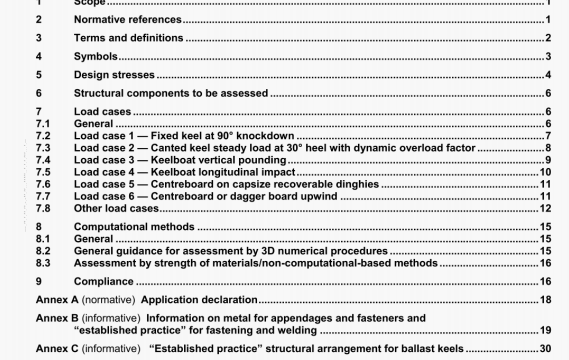ISO 12215-9 pdf download – Small craft一Hull construction and scantlings一 Part 9: Sailing craft appendages.
B.4.2 Prevention of electrolytic and galvanic corrosion
Electrolytic and galvanic corrosion shall be avoided. The grounding of electric ac. and d.c. components shall be checked in this respect.
On aluminium craft, non-aluminium fasteners shall be electrically insulated from the rest of the structure — for example, by inserting insulation bushings and washers.
B.5 Bolt screwing and pre-stressing
B.5.1 General
Screws and nuts shall be tightened to ensure pre.stressing, which has three main purposes:
a) to avoid fatigue: keel bolts, like any bolt, can be subject to fatigue loading; put simply, if a bolt is pretensioned to a load greater than the one it will experience in service, it will experience no change in stress, and no fatigue issue;
b) to avoid a gap opening up under load between the different elements (keel. jointmg compound, backing plate, etc.);
C) to avoid nuts workwig loose, although this can be obtamed by other means (sell-locking nut, resin, counter bolt etc.).
The nut shall not, however, be tightened excessively, to avoid too much stress being placed on the hull bottom or other elements.
Washers between the bolt head or nut and backing plate are needed to reduce friction while tightening. When removing nuts for inspection, replacement of the washer is recommended, and replacement of the nut shoLdd be considered, as pre-stress generally diminishes each time the nut Is re-used. When metals other than steel are used for bolts t is recommended that washers and backing plate made of the same metals (e.g. Nickel aluminium bolts) be used; see also Table D.2.
The pre-stresslng is generally achieved by tightening the bolt with a torque wrench (see B5.5), but this method has its drawhacks Some other devices — hydraulic pm-tensioning, measuring bolt extension with a micrometer (see B5.4), ultrasonic equipment, etc — are considered more efficient, as they avoid the extra shear load on bolts brought up by the tightening torque. Above all, these methods are considered to give a better indication of the level of pm-stress, which is not straightforward with the torque (see B.5.3). However. these devices are usually more expensive than the torque wrench.
B.5.2 Pre-stressing force
The determination of the pre.stressing force depends of several parameters, such as service force, screw and nut material, friction coefficient, lubrication and respective stiffness of the bolt and of all elements compressed. etc. There is a good deal of literature on the subject The German VOl 2230-1 and French NF E25-030-1 standards have very detailed specifications, both on pre-stressing and tightening torque. However, in most cases the aocuracy of the knowledge of all components of a keel bolting system in its environment will hardly be up to the level of large-scale industry practice.
the maxwiium width of the fin at its root;
— the maxr’ium spacing of bolts on a flanged keel.
The bending moment and shear force wtiich corresponds to the stress (or strain) first reaching the design value defined by EquatIon (1) shall be calculated using F.gureC.2, TableC.1 and the methods given In
ISO 12215-5.
The ratio of the offefed value to the reqw.red value shall no( be less than 1.0.
C.2.2 Determination of floor effectiveness
This annex provides a simplified method which does nd pretend to cover all keel support gird configurations. and in which the following assumptions are made.
— The floors carry 100% of the transverse bending moment and forces (load case 1). l.a. nothing Is carried by any longitudinal girders except, where relevant, when connecting these floors.
— In the absence of a stiff girder or pair 04 girders, only the floOrs which are directly connected to the ballast keel via keel bolts or that lie between the leading and trailing edges of the fin in the absence of bolts may be considered as effective. Floors fore or aft of this zone are neglected.
Where there isa stiff girder or pair of girders, all floors which are connected to that girder (or girders) may be considered effective. To apply this condition, the total girder stiffness shall be at least 50 % of the total floor stiffness. The stiffness of floors and rders shall be assessed as per C.2.3.
For grids composed of other than one centreline or two near-centreline girders, the methods of this annex are not applicable and the computational methods defined In Clause 8 shall be applied.
— For grids composed of no substantial floors, or floors which simply act as stiort4ength shear webs to connect a pair of near-oentreline girders. the methods of this annex are not applicable and the computational methods defined in Clause 8 shall be used.
ISO 12215-9 pdf download – Small craft一Hull construction and scantlings一 Part 9: Sailing craft appendages
